House of Aberffraw
The House of Aberffraw was a medieval royal court based in the village it was named after, Aberffraw, Anglesey (Wales, UK) within the borders of the then Kingdom of Gwynedd. The dynasty was founded in the 9th century by a King in Wales whose descendants founded the Welsh Royal Houses. The other medieval Welsh dynasties were the Royal Houses of Dinefwr and Mathrafal.[1]
| House of Aberffraw | |
|---|---|
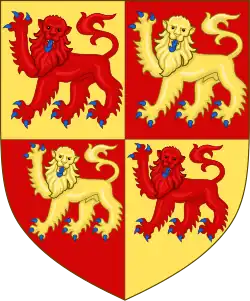 Traditional Arms of the Aberffraw House of Gwynedd | |
| Parent house | House of Gwynedd |
| Country | Wales |
| Founded | c. 9th century |
| Founder | Anarawd ap Rhodri |
| Final ruler | Prince Dafydd III |
| Titles |
|
| Connected families | Dinefwr Mathrafal |
| Deposition | 1283 |
The Royal House is deemed to be a historiographical and genealogical term historians use to illustrate the line of succession from Rhodri the Great of Wales through his eldest son Anarawd.[2][3] The last member of the male line of the house of aberffraw was Owain Lawgoch.[4]
Aberffraw hundred (cantref)
The name of the royal house derives from Aberffraw, on Anglesey (Ynys Môn) at the mouth of the River Ffraw. The royal court is where the early Kings of Gwynedd established their principal (chief) family seat.[5] The site was a preshistoric settlement later occupied during the Roman period (c. 0- 400 AD). The town became a Welsh Princely court (Welsh: Llys) and location of a royal palace as part of the administrative centre and one of the three county divisions (hundred, Welsh: cantref) of Anglesey.[lower-alpha 1][7][8][9] An early Gwynedd King, Cadfan ap Iago was buried at St. Cadwaladr's Church in the then Aberffraw hundred. Cadfan's tombstone (634 AD) is on display in the church today and reads:[7][10]
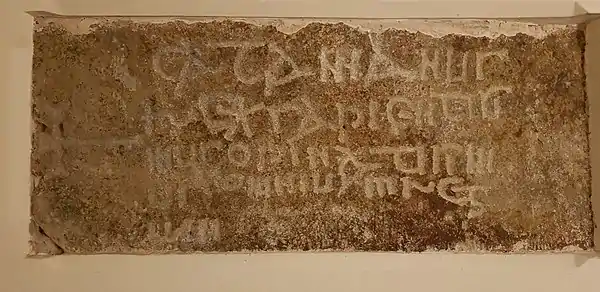
Latin: CATAMANUS REX SAPIENTIS MUS OPINATISM US OMNIUM REG UM.
English: King Cadfan, the Wisest and Most Renowned of All Kings.[11]
Welsh dynasties
In the 9th century, Rhodri the Great (Welsh: Mawr) had inherited multiple Welsh Kingdoms, Gwynedd from his father Merfyn Frych (Manx Chieftain), Powys from his mother Nest and he added Seisyllwg (Ceredigion and Ystrad Tywi) by a dynastic marriage to Angharad of Seisyllwg. Rhodri divided Wales into at least 3 provinces, his son Anarawd ap Rhodri was given the Kingdom of Gwynedd and founded the medieval dynasty the House of Aberffraw. Merfyn ap Rhodri was given the Kingdom of Powys. And another of Rhodri's sons, Cadell ap Rhodri was given the province of Deheubarth and began the House of Dinefwr. Wales was subsequently separated into North Wales, Mid Wales and South Wales respectively.[12][13][14]
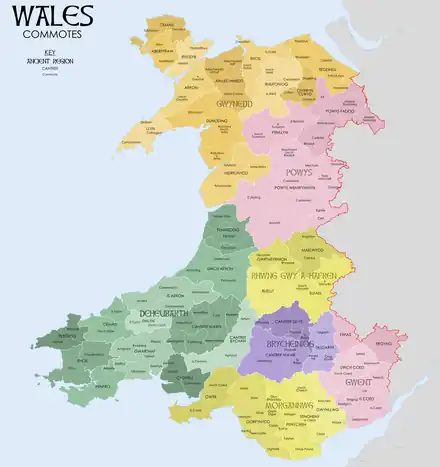
Succession
Royal succession within the House of Aberffraw (as with succession in Wales in general) was a complex matter due to the unique character of Welsh law.[15] According to Hubert Lewis, though not explicitly codified as such, the edling, or heir apparent, was by convention, custom, and practice the eldest son of the lord or Prince and was entitled to inherit the position and title as "head of the family" from the father. This was effectively primogeniture with local variations. However, all sons were provided for out of the lands of the father, and in certain circumstances so too were daughters (with children born both in and out of wedlock considered legitimate).[15] Men could also claim royal title through the maternal patrimony of their mother's line in certain circumstances (which occurred several times during the period of Welsh independence).[16] The female line of the dynasty was also considered to remain royal, as marriage was an important means of strengthening individual claims to the various kingdoms of Wales and uniting various royal families to that of Aberffraw, or reuniting factions after dynastic civil wars (for example with the marriage of Hywel Dda, a member of the Dinefwr branch of the Aberffraw dynasty, and Elen of Dyfed, daughter of Llywarch ap Hyfaidd, King of Dyfed).[17] This meant that the female line was considered as a legitimate path of royal descent within the House of Aberffraw, with the claims of royal women to titles usually transferring to their sons.
Cambro-Norse era
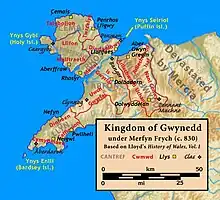
During the Cambro-Norse era (850s – 1100s), Wales was subjected to Viking raids all throughout the country between 852 and 919 (the Jómsvíkinga saga refers to that period). An example of this pattern was with the Viking leader Ingimund who was expelled from Dublin and tried unsuccessfully to establish a base on Anglesey (c. 902), but instead left for Chester.[18]
The Welsh Kingdoms had been subject to the Kingdom of Mercia from the 7th century onwards. This led to the construction of Offa's Dyke, a territorial land border between England and Wales built in the mid to late 8th century. However, war broke out against the English for decades from 853, this culminated in a victory for The Welsh Kingdoms of Gwynedd and Powys against the English Mercian and Wessex Kingdoms who had been assisted by Anglo-Saxons and Danes (Vikings).[13][19][20]
After successful battles for Rhodri the Great against the Vikings, beginning with the death of Horn the Dane (leader of the 'New Dubliners') in 856, Rhodri was then killed in battle against the Saxon leader Ceowulf of Mercia in 878 AD. But the Welsh would avenge their King with a victory over the English Mercians at the Battle of the Conwy in 881. During this period, Rhodri Mawr's sons were dependent for protection from the Scandinavian York Viking mercenaries.[13][18][21][22][23]
The second phase of Viking raids in Wales continued into the 10th century. Between the years 950–998, Wales saw raids, attacks, and slave raids with a devastating Viking raid happening at Aberffraw in 968. King Maredudd ab Owain would pay the ransom for the return of Welshmen. Then the third phase of Viking raids would coincide with the Norman invasion of Wales during the 11th century. This era saw a new alliance between the Vikings and the house of Aberffraw through the marriage of Gruffudd ap Cynan's father Cynan ab Iago to the daughter of a Norseman after he took refuge in the Kingdom of Dublin. After several attempts to retake Gwynedd from the Normans, Gruffudd eventually succeeded with assistance from Magnus Barefoot (King of Dublin, King of Norway and King of the Isles) in 1098 when they won the Battle of Anglesey Sound against the English Normans together.[18][24][25][26]
Power base (Norman invasion)
The family were able to assert their influence within Gwynedd, their traditional sphere of influence, but by the 11th century they were ousted from Powys (Mid Wales) and Deheubarth (West Wales) by a series of strong rulers from the House of Dinefwr in Deheubarth, their dynastically junior cousins. The Dinefwr family were descended from the Cadell ap Rhodri, the second son of Rhodri the Great. However, under Gruffudd ap Cynan, the house of Aberffraw was able to recover it's heritage and position during the Norman invasion of Gwynedd (1081 – 1100) with Cynan as King of Gwynedd defeating the Norman invaders.[27] Owain Gwynedd, Gruffudd's son defeated King Henry II of England and the vast Angevin host in the 1157 campaign and again in 1166. That led to Owain being proclaimed as the Prince of Wales (Latin: Princeps Wallensium) by other Welsh rulers. The proclamation reasserted and updated the Aberffraw claims to be the principal royal house of Wales, as senior line descendants of Rhodri the Great.[28][lower-alpha 2][lower-alpha 3]
Aberffraw senior line
Below is a partial family tree of the dynasty of Gwynedd.[30]
- Gruffudd ap Cynan (c. 1055–1137), Prince of Gwynedd
- Owain Gwynedd (c. 1100 – 28 November 1170), Prince of the Welsh, Prince of Gwynedd = Cristina ferch Gronw ap Owain ap Edwin
- Hywel ab Owain Gwynedd Prince of Gwynedd 1170 [lower-alpha 4]
- Caswallon ap Hywel [lower-alpha 5]
- Iorwerth ab Owain (1145–1174),
- Llywelyn ab Iorwerth (c. 1173 – 11 April 1240), de facto Prince of Wales, Prince of Gwynedd and Powys, Prince of Aberffraw and Lord of Snowdon. [lower-alpha 6]
- Rhodri ab Owain Gwynedd (c. 1146–1195), Lord of Anglesey = Annest ferch Rhys ap Gruffudd
- Hywel ab Owain Gwynedd Prince of Gwynedd 1170 [lower-alpha 4]
- Owain Gwynedd (c. 1100 – 28 November 1170), Prince of the Welsh, Prince of Gwynedd = Cristina ferch Gronw ap Owain ap Edwin
Princes of Wales (de facto)
The Kingdoms of Wales defended their territory from Anglo-Normans and subsequent Kings of England's military expeditions 21 times between 1081 – 1267. It was King Edward I of England who finally suppressed the Welsh Principality after Llywelyn ap Iorwerth (Llywelyn I, the Great) and his grandson, Llywelyn ap Gruffudd (Llywelyn II) had controlled all of medieval Wales. As Llywelyn II was a second son and direct (lineal) descendant of Rhodri Mawr and Owain Gwynedd, his succession caused number of problems within the House of Aberffraw. The 13th century Llywelyns, rulers of Wales controlled their neighbouring Kingdoms through a political framework whilst excluding and subduing the descendants of Norman marcher lords through warfare.[31][32]
Llywelyn the Great
By 1203 Llywelyn ap Iorwerth (Llywelyn I, the Great) had followed in the footsteps of his grandfather, Owain Gwynedd, and unified the divided Kingdom of Gwynedd. He further advanced to conquer all of Wales by 1207. King John I of England (Llywelyn's father-in-law) intervened in Powys returning the Kingdom to Prince Gwenwynwyn in 1209, however, the intervention caused a retaliation in the form of the Welsh uprising of 1211. Llywelyn would gain favour from Pope Innocent III who excommunicated King John and encouraged the Welsh Principality to rebel against English rule. After the signing of the Magna Carta on the 15th of June 1215, Llywelyn was recognised as Prince and ruler of all Wales. In 1216 Llywelyn the Great had received the fealty and homage of the Dinefwr rulers of Deheubarth at the Council of Aberdyfi.[33][34][35] With homage and fealty paid by other Welsh lords to Llywelyn at Aberdyfi, Llywelyn the Great became the de facto first Prince of Wales in the modern sense. This was confirmed in a 1218 meeting in Worcester, England by the next English monarch, Henry III. Llywelyn acted as Overlord to other nobles. By 1230 Llywelyn styled himself as the Prince of Aberffraw and Lord of Snowdon.[33][34]
13th century
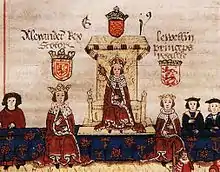
During the 13th century, Wales was ruled by Dafydd ap Llywelyn (Dafydd II), son of Llywelyn the Great. After the death of Dafydd II, the power was given to his nephew, Llywelyn ap Gruffudd (Prince Llywelyn II) who was granted the title of Prince of Wales by his English compatriot Henry III at the Treaty of Montgomery during 1267. Prince Llywelyn II was killed in action campaigning for Welsh independence in Cilmeri, December 1282. Of the Aberffraw dynasty the final Prince of Wales was Dafydd ap Gruffydd (Prince Dafydd III). After the death of Dafydd III's brother, the Prince himself would be tried for treason and executed in Shrewsbury, England by his once ally Edward I of England on 3 October 1283.[36][37][38] The consequences of the 1282-83 Conquest of Wales by Edward I greatly reduced the influence of the family. King Edward I forced the remaining members of the family to surrender their claim to the title of Prince of Wales under the Statute of Rhuddlan in 1284, which also abolished the independent Welsh peerage. The Aberffraw family members closest to Llywelyn II were imprisoned for life by Edward, while the more distant Aberffraw members went into deep hiding and fell into obscurity. Other members of the family did lay claim to their heritage; they included Owain Lawgoch as the lineal successor to Llywelyn II in the 14th century.[36][37][39]
Footnotes
- The palace (or llys) at Aberffraw was originally thought to have been located to the west of the village but recent research suggests it was likely located within the boundaries of the village itself.[6]
- Owain's Welsh position was further reaffirmed in the biography The History of Gruffydd ap Cynan. Written in Latin, the biography was intended for an audience outside Wales.[29]
- The significance of this claim was that the Aberffraw family owed nothing to the English king for their position in Wales, and that they held authority in Wales "by absolute right through descent", wrote historian John Davies.[28]
- eldest surviving son after the death of Rhun ab Owain, succeeding as his father's chosen heir. Died 1170 in battle at Pentreath, against his brother Dafydd. The Chronicle of the Princes (Brut y Tywysogyon) records the following entry in the year 1170: One thousand one hundred and seventy was the year of Christ when Dafydd ab Owain slew Hywel ab Owain (Red Book of Hergest Version translated and arranged by Thomas Jones, 1955). See in genealogical tables in J.E. Lloyd's History of Wales: The Line of Gwynedd.
- [see: PC Bartrum Welsh Genealogies AD 300–1400 (1974), page ref: Gruffudd ap Cynan 10]. Caswallon has proven direct male ancestors who exist into the modern day and thereby represent the senior surviving male line of Owain Gwynedd – the genealogy of one family was recorded by Peter Gwynn-Jones, late Garter King of Arms, at The College of Arms.
- The last of the Llywelyn line died out with the death of Owain Lawgoch in 1378
References
- Davies, John (2007). A History of Wales (Revised ed.). Penguin. ISBN 978-0140284751., Chapter 4
- Davies 1994, pp. 116, 128, 135, 136.
- Lewis 1889, pp. 192–200.
- Davies, John (2007). A History of Wales (Revised ed.). Penguin. ISBN 978-0140284751.
- Davies, John (2007). A History of Wales (Revised ed.). Penguin. ISBN 978-0140284751.
- "Aberffraw Palace, Aberffraw (15012)". Coflein. RCAHMW. Retrieved 15 September 2023.
- "Aberffraw (32986)". Coflein. RCAHMW. Retrieved 15 September 2023.
- "Aberffraw, Excavated Features, Rejected Roman Fort and Suggested Llys Site (401126)". Coflein. RCAHMW.
- Davies, John (2008), The Welsh Academy Encyclopedia of Wales, Cardiff: University of Wales Press , p. 113, ISBN 978-0-7083-1953-6
- Tout, Thomas Frederick (1885–1900). . Dictionary of National Biography. London: Smith, Elder & Co. p. 190.
- "St Cadwaladr". nationalchurchestrust.org. Retrieved 28 August 2023.
- Pierce, Thomas Jones (1959). "Rhodri Mawr ('the Great') (died 877), king of Gwynedd, Powys, and Deheubarth". Dictionary of Welsh Biography. National Library of Wales.
- Lloyd, John Edward (1896). . In Lee, Sidney (ed.). Dictionary of National Biography. Vol. 48. London: Smith, Elder & Co. p. 85.
- "MERFYN FRYCH (died 844), king of Gwynedd". Dictionary of Welsh Biography. National Library of Wales.
- Davies 1994, p. ?.
- Lloyd 2004, p. 220.
- Koch 2006, p. 945.
- Redknap, Mark (31 October 2008). "29". In Brink, Stefan; Price, Neil (eds.). The Vikings in Wales from: The Viking World. Routledge. pp. 401–404. doi:10.4324/9780203412770. ISBN 9781134318261. Retrieved 28 August 2023.
- Charles-Edwards, Thomas (2013). Wales and the Britons 350–1064. Oxford University Press. pp. 413, 486. ISBN 978-0-19-821731-2.
- "Offa's Dyke: built by multiple kings?". Current Archaeology. XXV, No. 3 (291): 6. June 2014.
- Davies, John (2007). A History of Wales (Revised ed.). Penguin. p. 80. ISBN 978-0140284751.
- Keynes, Simon (1998). "King Alfred and the Mercians". In Blackburn, M. A. S.; Dumville, D. N. (eds.). Kings, Currency and Alliances: History and Coinage of Southern England in the Ninth Century. pp. 19, 84. ISBN 0-85115-598-7.
- Carradoc of Lhancarvan (1697). The History of Wales. Translated by David Powel and. Augmented by W. Wynne. p. 38.
- Stephen, Leslie; Lee, Sidney, eds. (1890). . Dictionary of National Biography. Vol. 23. London: Smith, Elder & Co. pp. 301–304.
- Lloyd 2004.
- Power, Rosemary (October 1986). "Magnus Barelegs' Expeditions to the West". The Scottish Historical Review. Edinburgh University Press. 65 (180): 119. ISSN 0036-9241.
- Davies, John (2007). A History of Wales (Revised ed.). Penguin. ISBN 978-0140284751.
- Davies 1994, p. ??.
- Jones, Arthur (1910). The history of Gruffydd ap Cynan. Manchester University Press.
- Turvey 2010, p. 13.
- Turvey 2010, pp. 7, 10–11.
- Davies, John (2007). A History of Wales (Revised ed.). Penguin. ISBN 978-0140284751.
- "LLYWELYN ap IORWERTH (or 'Llywelyn the Great', often styled 'Llywelyn I', though in strictness the first prince of that name was Llywelyn ap Seisyll; 1173-1240, prince of Gwynedd". Dictionary of Welsh Biography. National Library of Wales.
- . Dictionary of National Biography. London: Smith, Elder & Co. 1885–1900.
- Davies 1994, p. 137–139.
- Pierce, Thomas Jones (1959). "Llywelyn ap Gruffydd ('Llywelyn the Last,' or Llywelyn II), Prince of Wales (died 1282)". Dictionary of Welsh Biography. National Library of Wales.
- Pierce, Thomas Jones (1959). "Dafydd ap Gruffydd (David III, died 1283), prince of Gwynedd". Dictionary of Welsh Biography. National Library of Wales.
- Tout, Thomas Frederick (1888). . In Stephen, Leslie (ed.). Dictionary of National Biography. Vol. 14. London: Smith, Elder & Co. pp. 202–205.
- Pierce, Thomas Jones (1959). "Owain ap Thomas ap Rhodri (' Owain Lawgoch '; died 1378), a soldier of fortune and pretender to the principality of Wales". Dictionary of Welsh Biography. National Library of Wales.
Sources
- Davies, John (2007). A History of Wales (Revised ed.). Penguin. ISBN 978-0140284751.
- Davies, John (1994). A History of Wales. London: Penguin Books. OCLC 650493756.
- Koch, Thomas (2006). Celtic Culture: a Historical Encyclopaedia. Santa Barbara, US: ABC-CLIO. ISBN 9781851094400.
- Lewis, Hubert (1889). "VIII". The Ancient Laws of Wales. London: Elliot Stock. OCLC 1304160411.
- Lloyd, J.E. (2004). A History of Wales; From the Norman Invasion to the Edwardian Conquest. New York, US: Barnes & Noble Publishing. ISBN 9780760752418.
- Turvey, Roger (2010). Twenty-One Welsh Princes. Conwy: Gwasg Carreg Gwalch. ISBN 9781845272692.
Further reading
- Chisholm, Hugh, ed. (1911). . Encyclopædia Britannica. Vol. 2 (11th ed.). Cambridge University Press.
- Morris-Jones, John (1911). . In Chisholm, Hugh (ed.). Encyclopædia Britannica. Vol. 28 (11th ed.). Cambridge University Press.
